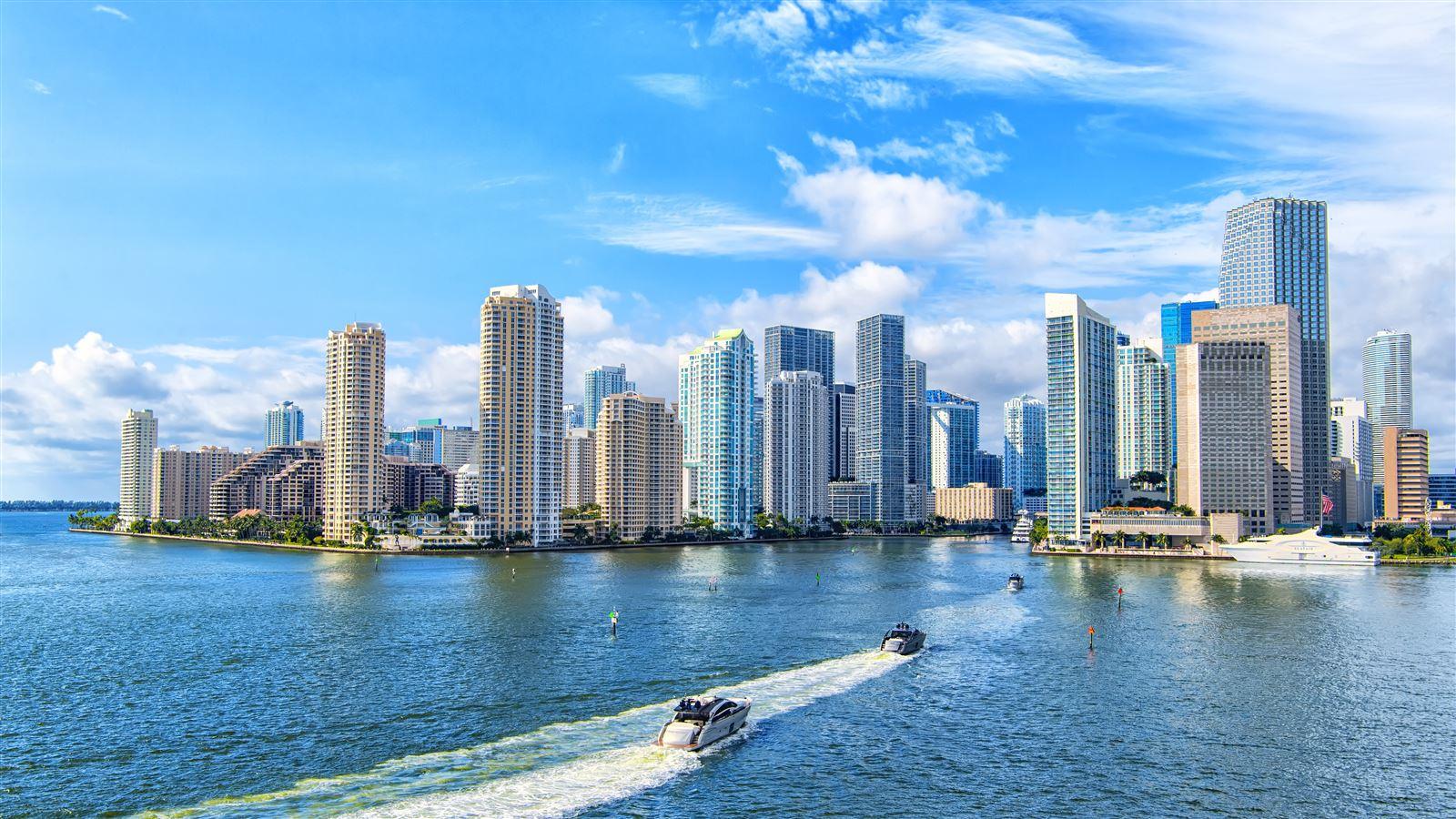Miami’s Roadmap to Stormwater and Coastal Resilience
The city of Miami, Florida, encompasses approximately 56 square miles—36 are located in upland areas, while the remaining 20 square miles are found within coastal basins and Biscayne Bay, and designated as Outstanding Florida Water (OFW) and granted special protection. Well-known as a bustling tourist destination and economic powerhouse, Miami also experiences significant flooding from extreme rainfall and tidal events in addition to sea level rise, changes in land use from re-development and frequent regulatory environment changes.
CDM Smith originally developed the city’s 1986 Storm Drainage Master Plan, which included a Capital Improvement Plan (CIP) of $267 million of exfiltration and positive drainage systems after treatment to provide flood protection and protect the water quality in Biscayne Bay. Building upon that foundation, the team developed an updated Stormwater Master Plan (SWMP) for the Wagner Creek and Seybold Canal systems in coordination with the Miami River Commission in 1999 to improve water quality in the river, provide flood control improvements, among other benefits.
Subsequently, facing sea level rise driven by climate change, and with rainfall and rainfall flooding increasing in frequency and impact, Miami once again enlisted the help of CDM Smith’s stormwater management experts to develop a newly updated and comprehensive SWMP that could serve as the blueprint for capital project and operational recommendations for existing and future climate conditions over the next 50+ years.
“When I started my career at CDM Smith in 1986, one of my first projects I worked on was the original stormwater master plan for the city of Miami,” said Mike Schmidt, PE, BCEE, DWRE and lead engineer for the project. “Having the opportunity to update that plan and solve for the unique challenges facing the city today has been rewarding, especially as our ability to provide lasting solutions has grown.”
The most common question I get asked is whether Miami is going to be here in 50 years, whether it’s going to be here in 100 years. This is the beginning of having a comprehensive plan to answer that question in the affirmative.
Getting Started: Data Collection and Evaluation
To accomplish its resiliency and sustainability goals, the team began with initial data collection and evaluation to define the city’s Primary Stormwater Management System (PSMS). This update built on review of the city’s SWMPs previously conducted in 1986, 1999, and 2012 and other available and applicable data sources. More than 30,000 paper maps and archived documents with physical characteristics of the area were digitized, along with the current levels of service (LOS; performance metrics determining how well a system operates), geographic information system (GIS) records, tidal boundary conditions and data from FEMA. When all of the city’s available data was analyzed, a data gap analysis was performed and survey teams were deployed to discover and fill in the minimum missing data required to continue the analysis and complete the model.
Once gathered, a modern GIS and geo-database was developed for “one-click” access to the compiled records, which will continue to serve as a living e-document for future analyses and data query. The city can now also input data as new projects are completed and update the model as changes in rainfall, sea level rise, groundwater table elevation or land use are realized.
Stormwater Modeling and Infrastructure Recommendations
Based on the information gathered, the team developed a United States Environmental Protection Agency (USEPA) StormWater Management Model (SWMM) of the city’s eight drainage basins and used the SWMM to evaluate the city’s ability to handle flooding from rainfall events and tidal conditions. The models were validated to actual conditions for historic storms and then were used to confirm problem areas, determine flood protection LOS, and create flood zone maps under simulated conditions for 5-, 10-, 25- and 100-year storms.
During the sea level rise and tidal surge evaluation, the team simulated two future increases of 18 and 30 inches, various related scenarios with higher groundwater levels, potential seawall height requirements to support the city’s ordinance for coastal armoring and seawall protection at various storm surge heights, and resiliency planning for a “worst case” storm occurring with a peak high tide and storm surge event. The results were used to help the city understand its stormwater and coastal management system vulnerabilities with relation to surge and sea level rise, and to provide a basis for adaptation strategies, policies, and infrastructure design. Lastly, a multi-tiered capital improvement program was created to address flooding and stormwater improvements in high-impact zones.
Public Participation and Crowdsourced Data Solicitation
Throughout the project, stakeholder and resident workshops were held in the various Commission Districts at critical points during the assessment. Special care was taken to communicate clear, easy-to-understand information in multiple languages in order to ensure inclusivity for all members of Miami’s diverse community. Residents were asked to provide their own personal experiences to help inform the overall project goals.
"We went out into the neighborhoods and asked residents to place dots on our GIS maps to tell us where the worst flooding problems occur in their own neighborhoods. We then used those dots and matched them up with our models as validation data,” says CDM Smith project manager Jonathan Goldman, PE, PMP, BCEE. This helped the team not only solicit much-needed feedback from city residents, but also help build trust and collaboration within the community. In addition, experts from regulatory agencies and other engineering firms were invited for an open discussion about the scope of work, techniques, and methodology being used for analysis.
“Eventually, people became more familiar with phrases like ‘sea level rise’, ‘flooding levels of service’ and ‘storm surges.’ That knowledge transfer proved invaluable because in our case, more public involvement and education led to overall public acceptance,” says Goldman.
Cost-effective Capital Improvement Plan for Significant Benefits
CDM Smith developed a CIP that consisted of more than 200 miles of exfiltration, protection for more than 93 miles of shoreline and 490 stormwater outfalls, more than 2,000 recharge wells to reduce saltwater intrusion and volume discharged to Biscayne Bay, and over 80 pump stations after treatment. The CIP was developed in two LOS tiers and ranges from $3.8 billion to $5.4 billion. The FEMA Hazard US (HAZUS) tool was for benefit/cost analyses and B/C ratios range from 2.8 to 3.8 to 1.0 for current and future sea level rise conditions, including significant flood damage reduction value. This will support grant funding and bonding as needed to fund the program long term.
Miami's Path Forward
As the city develops a roadmap toward resiliency, the SWMP is intended to be more than an adopted, shelved report. Miami will now use its SWMP as a guide to resilience and support for project prioritization and phasing; grant, loan, bond and cooperative stakeholder funding; Environmental Resource Permitting, and development and re-development standards and guidance. As projects are advanced, the GIS and SWMM models will be updated with the latest outputs and any deviations from the ideal sequencing will be tested for effectiveness. Results are digitally available in the city’s GIS environment for open use by designers as a single source of common information, helping to further expedite the design, review, tracking and permitting processes.
Miami’s residents also have an important part to play in realizing the city’s future resiliency goals. The use of crowd-sourced data solicitation, while encouraging residents to stay informed about the key services that their stormwater systems provide, will help to build long lasting support for the management of these critical systems.
Residents will continue to be kept informed through consistent public outreach workshops and education programs, especially regarding mitigative actions they can take to safeguard Miami for years to come.
As Miami Mayor Frances X. Suarez told the Miami Herald, “The most common question I get asked is whether Miami is going to be here in 50 years, whether it’s going to be here in 100 years. This is the beginning of having a comprehensive plan to answer that question in the affirmative.”

Having the opportunity to solve for the unique challenges facing the city today has been rewarding, especially as our ability to provide lasting solutions has grown.
What is a Stormwater Master Plan (SWMP)?
A SWMP is a comprehensive approach to define stormwater goals, levels of service, problem areas, and cost-effective mitigative measures that can be phased in over time. The SWMP uses models that simulate rainfall, tides, topography and land use to identify deficiencies within a city’s stormwater management system and recommend the corrective actions.
Done right, a SWMP can provide the structure for a city to establish a multi-faceted improvement plan to protect public safety, infrastructure and the environment.















